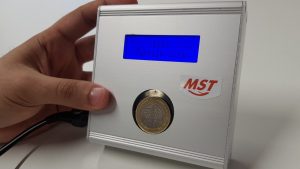Photo: Prototype of an eddy current coin classifier of the Chair of Measurement and Sensor Technology, which was developed in cooperation with a Chemnitz company.
From 24. until 27. September 2019, the Chair of Measurement and Sensor Technology at Chemnitz University of Technology has invited more than 100 participants from 15 countries to attend the 12th International Meeting of Measurement and Sensor Technology at Chemnitz University of Technology. International Workshop on Impedance Spectroscopy (IWIS). The conference is organized by the Institute of Electrical and Electronics Engineers (IEEE) and the German section of the IEEE Instrumentation and Measurement Society. The focus this time is on spectral measurement techniques and electrical impedance methods.
Special topics are chemical energy storage, fuel cells, bioimpedance, sensors and nanomaterials. The workshop programme will be framed by plenary lectures: Prof. Andrzej Lasia (Université de Sherbrooke, Québec, Canada) will talk about the kinetics of hydrogen reactions and their characterization with impedance spectroscopy. Prof. Pasquale Arpaia (Università di Napoli Federico II, Italy) reports on the use of impedance spectroscopy in microinstrumentation for measuring transdermal delivery of drugs. Electrochemical sensors for the detection of bio- and chemical substances and the design of electronic tongues will be presented by Prof. Leonardo Giordano Paterno (University of Brasilia, Brazil) and Dr. Najla Fourati (Conservatoire National des Arts et Métiers, France), demonstrating the excellent capability of the method in in-process analysis of substances in the environmental, agricultural and medical fields. Prof. Jan Gimsa (University of Rostock) will report on modeling approaches for suspensions of ellipsoidal particles and will discuss the compatibility between the electrostatic orientation approach and the maximum entropy approach. Prof. Giorgio Ferrari (Politecnico di Milano, Italy), who specializes in the development of low-noise measurement systems, reports on the application of impedance spectroscopy in micro- and nanosystems and on high-performance measurement systems with a resolution down to the zeptofarad range. From the field of material characterization Prof. Chris Bowen (University of Bath, UK) on microstructural networks in piezo materials for realizing high permittivity.
Due to the mixture of fundamental topics, methodological developments and application examples, guests from various fields of expertise, which use impedance spectroscopy in different application areas, are expected to attend the workshop. Commenting on this, the organizer of the workshop, Prof. Dr. Olfa Kanoun: “The workshop has now become the world’s most important meeting place for specialists and users in the field of impedance spectroscopy. We saw another significant increase in both the quality and scope of the workshop this year.” In addition to the wide range of contributions on chemical energy storage systems, the contributions on sensors and sensor systems were particularly well represented this year. “We are ourselves present in this field with work on spectral eddy current sensing and coin classification. But the application areas of agriculture, biomedicine and environmental monitoring are also following a long-term trend of using radio-based sensor networks to tap new sources of information and make previously unused correlations measurable or to open up new application areas,” says Kanoun and adds: “If you consider, for example, the problems with nitrates in groundwater and nitrogen oxides in the air, you can immediately see a tremendous social relevance in these areas.” All these topics are successfully pursued by the Chemnitz Professorship and the workshop offers an excellent opportunity to exchange ideas with the scientists on these topics. As the workshop’s initiator, Kanoun says: “We are proud to be part of the international workshop, now in its 12th year. This year’s event will be the first of its kind, showcasing the latest developments and bringing experienced scientists into close contact with young scientists.”
